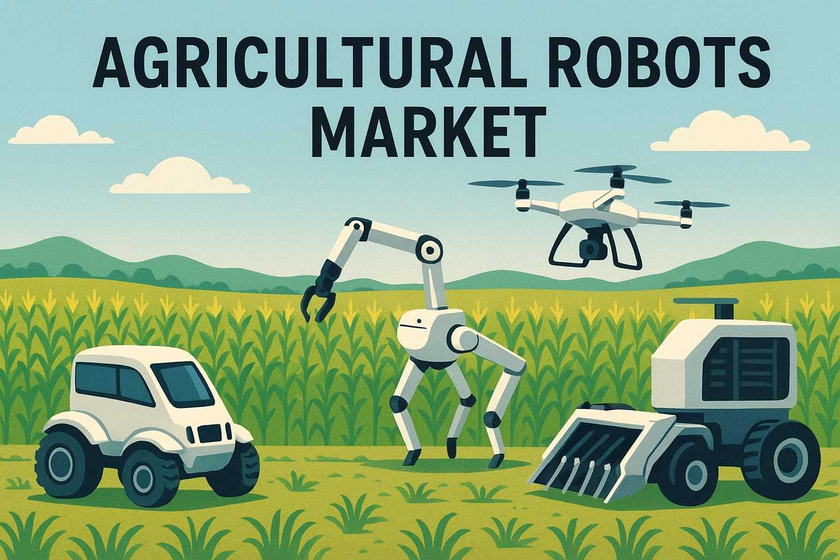The global agriculture sector is undergoing a technological revolution, and automation stands at its core. Among the most transformative innovations are agricultural robots, designed to boost efficiency, reduce costs, and address labor shortages in farming. These smart machines are no longer futuristic concepts but practical tools being deployed across fields worldwide. With advanced capabilities in harvesting, planting, crop monitoring, and weeding, agricultural robots are reshaping modern farming practices.
According to recent industry insights, the Agricultural Robots Market Size was valued at USD 11.31 Billion in 2024 and is expected to reach USD 43.67 Billion by 2032, growing at a robust CAGR of 18.4% during the forecast period 2025–2032. This remarkable growth underscores the rising demand for automation in agriculture, fueled by population growth, climate change pressures, and the need for sustainable food production.
Drivers of Growth
Several factors are propelling the rapid adoption of agricultural robots:
Labor Shortages – The farming industry worldwide faces declining availability of manual labor, especially for time-sensitive and physically demanding tasks such as harvesting and planting. Robots provide a reliable alternative.
Precision Agriculture – The demand for precision farming practices to optimize resource usage (water, fertilizers, pesticides) is increasing. Robots equipped with AI and IoT sensors enable real-time monitoring and targeted applications.
Sustainability Goals – With climate change and environmental concerns at the forefront, agricultural robots contribute by reducing waste and promoting eco-friendly farming methods.
Government Support – Many countries are offering subsidies and incentives for farmers to adopt automation and robotics to ensure food security.
Technological Advancements – Continuous innovations in artificial intelligence, drone technology, autonomous vehicles, and machine vision are improving the functionality and cost-effectiveness of agricultural robots.
Market Segmentation Insights
The agricultural robots market can be segmented based on type, application, and region.
By Type – Driverless tractors, unmanned aerial vehicles (drones), robotic harvesters, milking robots, and automated weeding machines are some of the most popular categories. Driverless tractors and drones are witnessing rapid adoption due to their ability to cover large areas efficiently.
By Application – The technology finds usage in harvesting and picking, irrigation management, crop monitoring, dairy management, and soil analysis. Among these, harvesting robots are particularly gaining traction as they significantly reduce time and manual effort.
By End-Users – Large-scale farms and commercial growers are the primary users, but small and medium-sized farmers are also gradually embracing automation with the availability of cost-effective robotic solutions.
Regional Growth Outlook
The global Agricultural Robots Market is expanding across all regions, but growth trends vary:
North America leads the market due to early adoption of advanced farming technologies, large-scale commercial farming, and supportive government initiatives. The U.S. is a major contributor.
Europe is rapidly growing, with countries like Germany, the Netherlands, and France focusing on precision farming and sustainable agriculture practices.
Asia-Pacific is expected to witness the fastest growth during 2025–2032, driven by high population density, food security needs, and increasing government investments in smart farming technologies. China, Japan, and India are key contributors.
Latin America is emerging as a potential growth region due to its vast agricultural land and increasing need for automation to improve productivity.
Future Opportunities
The future of agricultural robots lies in AI-powered autonomous systems that can handle complex tasks without human intervention. Integration of machine learning, data analytics, and IoT devices will enhance predictive capabilities, allowing farmers to make data-driven decisions. Furthermore, collaborative robots (cobots) designed to work alongside humans are gaining attention, bridging the gap between traditional practices and full automation.
Another significant opportunity is in vertical farming and indoor agriculture, where robots can monitor controlled environments and automate planting and harvesting with precision. Startups and established players alike are investing heavily in developing solutions tailored to urban agriculture.
Competitive Landscape
The market is highly competitive, with both global giants and startups innovating aggressively. Leading companies are focusing on partnerships, product launches, and acquisitions to strengthen their positions. Some of the prominent players include John Deere, AGCO Corporation, Kubota Corporation, CNH Industrial, Trimble Inc., and DeLaval. Many of these companies are integrating AI, machine learning, and cloud technologies into their offerings to provide farmers with holistic solutions.
Conclusion
The agricultural sector is at the threshold of a new era where robots will play a vital role in ensuring food security, sustainability, and profitability. The Agricultural Robots Market Size, projected to reach USD 43.67 Billion by 2032, signifies the industry’s confidence in automation as a cornerstone of modern farming. With rapid adoption in developed economies and strong potential in emerging markets, agricultural robots are no longer optional but an essential investment for the future of farming.
FAQs
Q1: What does CAGR mean in the context of the Agricultural Robots Market?
CAGR (Compound Annual Growth Rate) represents the average yearly growth rate of the market over a specific time frame. For agricultural robots, the CAGR is 18.4% between 2025–2032.
Q2: What does the forecast period 2025–2032 indicate?
The forecast period reflects the projected timeline during which market trends, growth drivers, and adoption rates are analyzed to estimate future performance.
Q3: Which region is expected to show the highest growth?
Asia-Pacific is anticipated to witness the fastest growth, driven by rising food demand, government initiatives, and adoption of smart farming technologies in countries like China, India, and Japan.


















